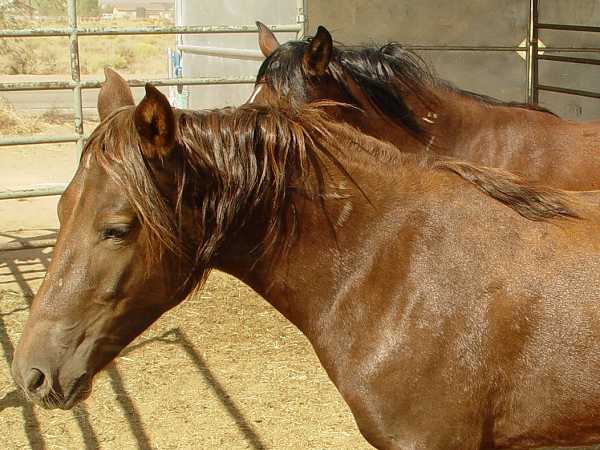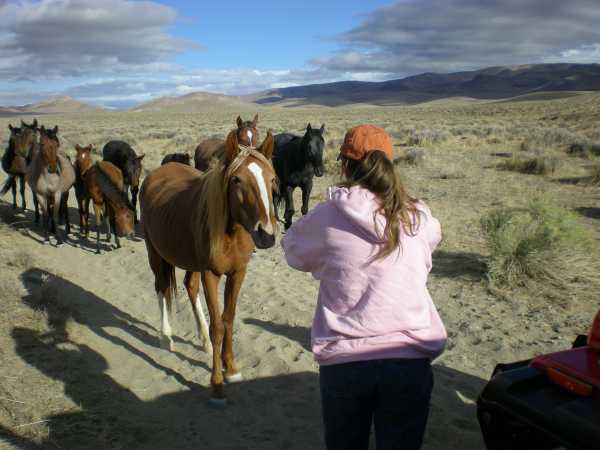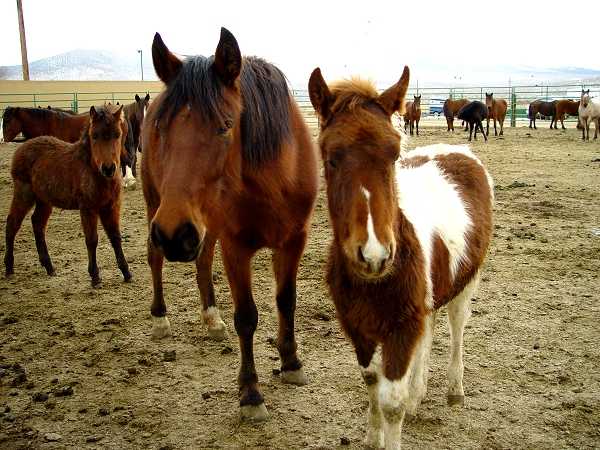Carson City, NV
For about eight years veterinarian David Thain has been conducting trials for the University of Nevada Reno observing horses held at the Stewart Dairy that had been given temporary birth control vaccines. The purpose of these trials was to see if the vaccines were effective and whether any long term side effects might be produced by these drugs.
Management of wild horse populations is a serious issue. While a majority of citizens clearly want to preserve viable herds of wild horses on our public lands, horse populations do need to be kept in balance with available resources. Herd management strategies should follow the multiple use doctrine that governs use of our public lands as well as applicable laws. Safe temporary birth control for horses could be a viable and cost saving tool to achieve these management objectives as it could keep the number of new foals pretty much equal with the mortality rate of a herd, but at the same time preserve maximum genetic diversity. The same diverse numbers of mares could produce foals, but each mare would simply have fewer foals over her lifetime.
Such a theory is great. However before thousands of horses are dosed with available birth control formulas, credible studies had to be undertaken to determine which formulas worked, how well they worked, what side effects they might cause, and how the formulas could be improved to avoid undesirable side effects and improve the effectiveness of birth control.
Dr. Thain researched two temporary contraceptives, Gona-Com and Spay-Vac. His studies started with two separate groups of mares, each with its own stallion. The horses were held in large corrals at the Stewart Dairy complex at the Northern Nevada Correctional Center. The horses were freezebranded and microchipped for identification, then a certain number of mares in each group were given birth control while a few "control mares" did not. The treated mares were compared with the non-treated mares to determine the effectiveness of the vaccines and to compare the long term health of the treated mares with the untreated mares.
The neck brands on these mares being cared for by the horse group, LRTC,
indicate that they are part of the study and were given birth control in 2007.

As trends were established by observing the horses in the pens, the study expanded to observing horses that were trapped, treated with birth control, and released back onto the range. After all, learning what happens to the horses under a real-life conditions is the most important aspect of such a study. Could the same results be produced in free-roaming horses as in the study corrals?
Formal field observations were conducted by a UNR undergraduate and many of the horses were also checked by volunteers affiliated with some of the region's wild horse groups.
LRTC volunteers checking on one of the birth controlled bands of horses.

As the studies focused more on field observations, one of the two groups of horses in the study corrals was disbanded and those horses were sent to the Wild Horse Foundation to be placed with adopters. However the other study group remained intact and monitoring continued.
There was still value in observing the remaining original group of birth controlled horses. Did any adverse side effects start to appear years later in the birth control horses? Did the birth controlled mares produce normal, healthy foals after the birth control wore off? Why did birth control work longer on some horses than on others? Continued observations could help in the evolution of safer and more effective birth control methods.
Money has gotten tight. Dr. Thain was advised that his "pen program" had lost its funding and that replacement funds were not available through the University or Department of Agriculture. As a result the wild horse groups raised the funds necessary to continue the pen program through the end of 2008 and developed a strategy where the horses could be moved to a privately managed range habitat in 2009. The horses could still be observed, a few mares given additional doses of birth control, and their environment would be more like real-life range conditions.
Director of Agriculture Tony Lesperance responded by placing a legal notice in the Nevada Appeal where he claimed that the program horses to be estrays, giving the owners a week to come forward and prove ownership or the animals will be disposed of. This guy is so sleazy that he didn't even place the notice under his own name. The notice was supposedly placed by a subordinate employee without that employee's permission or even with his knowledge.
Read the Legal Notice (in a new window.)
To put it simply, the hierarchy of Nevada's Department of Agriculture is staffed with liars. Some are clever. Dr. Phil LaRussa claimed that he "had not specifically heard from advocates over a solution to the 28 horses." That statement implies that he knew something was up but not the specifics. Aside from verbal information that was passed on to Dr. LaRussa prior to the placement of the legal notice required for disposal of the horses, Dr. LaRussa also received a copy of an email from me to Dr. Thain explaining that we just needed instructions as to when and where to have the hay delivered to the horses.
Read the Email (in a new window.)
Some of the staff at the Department aren't even clever with their lies. They seem to forget that people take recorders to meetings and capture news broadcasts on TeVo. Yet these folks still will on occasion insist that they didn't say what others have recorded. How dumb is that?
With respect to Dr. LaRussa's "open door" to talk with horse advocates, it's nothing more than a hologram. We have met with Dr. LaRussa and our experience is that such meetings are nothing more than a slight of hand operation with LaRussa having no authority to deal with anything. Thus far such meetings have simply given the Department opportunities to gather intelligence about the wild horse groups. With respect to Director Lesperance, during the various times wild horse advocates have appeared at Board of Agriculture meetings and presented the issues, Director Lesperance has yet to utter a single word. All this is public record. So much for true willingness to communicate.
The salient point is that the wild horse groups have historically, and still currently, provide funding and services to help maintain the Virginia Range horses. The Department of Agriculture neither has the personnel or financial resources to do it all. However Director Lesperance's actions clearly portray a man whose agenda is to eliminate the Virginia Range herd, no matter what it costs the taxpayers to do so.
Lesperance's claim is that his intent is to protect agriculture. However it is the wild horse groups who have consistently worked with the region's major legitimate agricultural operators to mitigate problems that the horses might pose and produce non taxpayer funded solutions that produce benefits for both agriculture and the horses. Lesperance seems obsessed with catering to a few outlaws who like to dump their cattle wherever they can, claim that they own land that they don't, and expect the taxpayers to fence state highways to keep their roaming cattle safe and remove horses that are eating "their" grass.
Lesperance is part of an administration that appears to manufacture its own reality in order to advance its agendas and pay patronage to special interests, regardless as to public opinion or impact to the state treasury. Lesperance's actions appear to have also stymied the field portion of the birth control study. In spite of the Department's assertions to the contrary, horses that are picked up are no longer being provided birth control and being released back onto the range. So not only is Lesperance's obsession interfering with science, it is interfering with stabilizing the horse population on the Virginia Range. And Lesperance, apparently with the aid of State Assemblyman Tom Grady and State Senator Mark Amodei, isn't above lying to the state's Interim Finance Committee to get taxpayer funds to advance his agenda. This, too, is public record yet Grady and Amodei went on the record defending Lesperance's claims.
It seems that if you work in the Gibbons administration and you report improper activities, you get removed as Administrative Services Officer
Mary Keating found out after she discovered Governor Gibbons had sent over 850 personal text messages from a state cellular phone at state expense to a female "longtime friend."
Keating is now suing the state.
Welcome to Nevada.
| 


